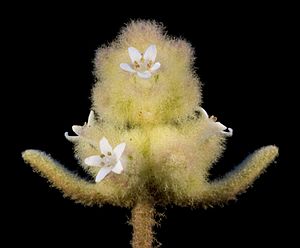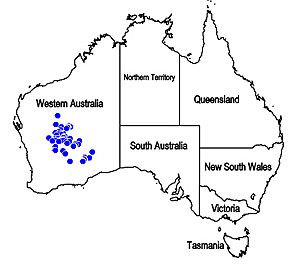Dicrastylis brunnea facts for kids
Quick facts for kids Dicrastylis brunnea |
|
|---|---|
 |
|
| Scientific classification | |
 |
|
| Synonyms | |
|
Dicrastylis brunnea var. pedunculata Munir |
Dicrastylis brunnea is a type of flowering plant. It belongs to the genus Dicrastylis and the plant family Lamiaceae. This plant is special because it grows only in the south-west part of Western Australia. This means it is "endemic" to that area.
Contents
What Does Dicrastylis brunnea Look Like?
Dicrastylis brunnea is a thick, bushy plant. It can grow from about 20 centimeters (about 8 inches) tall up to 2 meters (about 6.5 feet) high. Its stems are mostly round.
Leaves and Flowers
The leaves grow in pairs on opposite sides of the stem. They are 10 to 35 millimeters long and 5 to 12 millimeters wide. The leaves have tiny, branched hairs. They also have a bumpy or wrinkled surface.
The flowers of this plant do not have stalks. This means they sit directly on the stem. The calyx, which is the outer part of the flower, has five parts. These parts are 3.5 to 4 millimeters long. They are also covered in branched hairs.
The main part of the flower, called the corolla, is white or cream-colored. It is 6 to 8 millimeters long. The inside of the flower does not have any dots or stripes. Each flower has five stamens, which are the parts that produce pollen. You can see these flowers in January, August, September, or October.
Where Does It Grow?
This plant is found in several natural areas of Western Australia. These areas include Coolgardie, Gascoyne, the Great Victoria Desert, and Murchison. These are all part of the IBRA regions, which are special areas based on their plants and animals.
Who Discovered Dicrastylis brunnea?
The plant Dicrastylis brunnea was first officially described in 1978. It was named by a scientist named Ahmad Abid Munir. When scientists describe a new species, they give it a unique name. This helps everyone know exactly which plant they are talking about.

